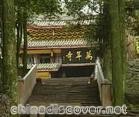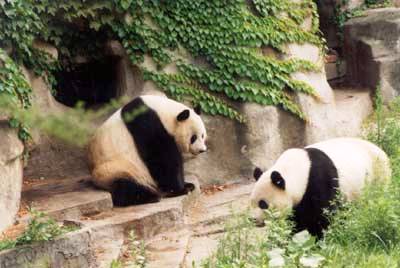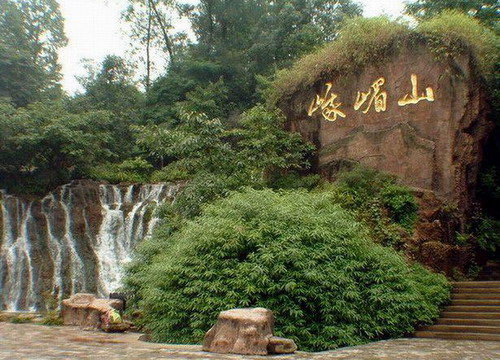Temples on Mount Emei

Overview
The route to the summit crosses a lush and diverse landscape with enchanted rock formations, waterfalls and narrow gorges. Climbing upwards you'll encounter countless temples and pavilions. Thousands of pilgrims walk the way to the top-many of them elderly and sporting canes with their pockets filled with incense and ghostdom paper money to be burned.
Know more
The first temple erected on the mountain was built during the Han dynasty, and during the Ming and Qing dynasties, Emei shan became one of China's most important centers for Buddhism. Many of its 100 temples fell into disrepair after the fall of the Qing dynasty, but since 1976, much has been done to restore past glory.
by far the more beautiful path to the top follows the southern route, which is also the longest. However, you'll be rewarded with marvelous landscapes and pass by colonies of monkeys. A word of warning, don't monkey around with the monkeys-they can be aggressive and they'll steal right out of your bag if you happen to open it in front of them. But if you act humbleand show them your empty hands, they're also smart enough to go look for wealthirer prey. Either that or buy a strong walking stick for self-defense.
Fuhu Temple
"Crouching Tiger Monastery", as it is known in Chinese, is sunk in the forest. Inside is a seven-meter-high copper pagoda inscribed with Buddhist images and texts. The renovated Fuhu Temple is sunk deep within the forest. Inside is a 7 m-high copper pagoda inscribed with Buddhist images and texts.
is sunk in the forest. Inside is a seven-meter-high copper pagoda inscribed with Buddhist images and texts. The renovated Fuhu Temple is sunk deep within the forest. Inside is a 7 m-high copper pagoda inscribed with Buddhist images and texts.
Wannian Temple
The Wannian Temple of 10000 Years is the oldest surviving Emei monastery. Its dedicated to the man on the white elephant, the Bodhisattva Puxian, who is the protector of the mountain.
This monastery is the oldest surviving Emei Temple (reconstructed in the 9 th century). It's dedicated to the man on the white elephant, the Bodhisattva Puxian, who is the protector of the mountain. This 8.5 m-high statue is dated from AD 980, cast in copper and bronze and weighs an estimated 62,000 kg. If you can manage to rub the elephant's back, good luck will be cast upon
 you.
you.
The statue is housed in Brick Hall, a domed building with small stupas on it. When the temple was damaged by fire in 1945, Brick Hall was the only building left unharmed. There is also a graveyard to the rear of the temple.
Qingyin Pavillin
Named the Pure Sound Pavillin because of the sound effects produced by rapid waters cousing around rock formations in the area, the temple itself is built on an outcrop in the middle of a fast-flowing stream. There are small pavillions from which to observe the waterworks and appreciate the natural music.
There are several small pavilions from which to observe the waterworks and appreciate the natural music. It's possible to swim here although the water is only likely to be warm enough during the summer months.
Xixiang Pond
According to legend, the Elephant Bathing Pool is the spot where Puxian flew his elephant in for a big scrub, but there's not much of a pool to speak of today. If very lucky, you'll meet some monkeys here. The monkeys have got it all figured out-Xixiang Pond is the place to be. If you come across a monkey "tollgate" ,the standard procedure is to thrust open palms towards the outlaw to show you have no food.
Monkey Etiquette
The monkeys have got it all figured out. If you come across a monkey 'tollgate', the standard procedure is to thrust open palms towards the outlaw to show you have no food. The monkeys are integral part of the Emei trip.
Some of these chimps are big, and staying cool when they look like they might make a leap at you is easier said than done. There is much debate as to whether it's better to give them something to eat or to fight them off.
One thing is certain, if you do throw them something, don't do it too much moderation. They get annoyed very quickly if they think they are being undersold.

Golden Peak
If the weather cooperates, the vista is divine at the 3,077m high Golden Peak. This is the place to relax, meditate and enjoy the sunset. The sunrise is also one of China's legendary experiences, but enjoying this means hiking up at night to be at the peak by sunrise.
Golden Summit Temple
At the Golden Summit with a altitude of 3077 m, this magnificent temple is as far as most hikers make it. It has been entirely rebuilt since being gutted by a fire several years ago. Covered with glazed tiles and surrounded by white marble balustrades, the temple now occupies 1695 square meters. The original temple had a bronze-coated roof, which how it got the name of Jinding.
It's constantly overrun with tourists, pilgrims and monks, and you'll be continuously bumped and jostled. The sun rarely forces its way through the mists up here and the result is that it is usually impossible to see ver far past your own nose. From the Golden Summit it was once possible to hike to Ten Thousand Buddha Summit (Wanfo Ding) but pilgrims now take a monorail.








